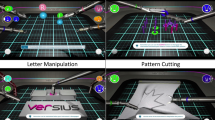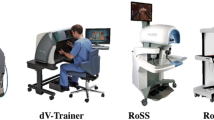Abstract
The scenario of robotic surgery is rapidly evolving with the introduction of new robotic systems. A structured learning program in robotic surgery during academic education is often lacking, especially for undergraduates; as a result, many students may be unaware of indications to robotic surgery and technological progress. The aim of the study is to evaluate the knowledge and interest toward robotic surgery of medical and nurse students, and to analyze how the attractiveness may change after a hand-on training course with new simulators of Hugo RAS and Versius System. We performed a cross-sectional study involving medical and nurse students recruited on a voluntary basis at ASST Santi Paolo and Carlo, Milan; participants were invited to join a hands-on practice simulation with the Hugo RAS and/or Versius Trainer Simulator. Before the hand-on exercise, students were asked to fulfill an online anonymous questionnaire addressing knowledge and interest toward robotic surgery. After a 2-h hands-on exercises at the Hugo RAS and/or at the Versius Trainer simulator (preceded by a brief lecture on robotic surgery and new systems), participants were asked to complete a second-round questionnaire to evaluate changes in attractiveness toward robotic surgery. Data were recorded in a database; after a descriptive analysis of the variables, median values were compared with the Mann–Whitney U test, frequencies with the Fisher’s exact test and in the case of paired observations (before and after the simulation), the Mc Nemar test was used. Forty-one undergraduates agreed to participate. Twenty-three nursing students and 18 medical students were recruited. Some of them had a basic knowledge in robotic surgery and were able to figure out some surgical indications, given the presence of a robotic program already settled up at the institution. Before the hands-on course, 44.0% nurse students and 36.6% of medical students were interested in surgical disciplines and robotic surgery. After the simulation, all students (100%) reported a high level of interest in robotic surgery and some of them required for a dedicated internship (p < 0.001). The students provided also feedback on the perceived ease-of-use of the robotic simulators (on a scale 0–10); overall, the median score was 8, IQR [7–8], with no differences between nursing and medical students (p = 0.482). In conclusion, the study demonstrates a great interest toward robotic surgery as a part of medical and nurse education. A hands-on simulation further improved the interest of undergraduates from both backgrounds. The technological progress with the availability of new surgical systems will be the future challenge of training programs and should be considered at all levels of education.
Similar content being viewed by others
Data availability
Data are available in a dedicated database and can be shown if requested by the Journal.
References
Fieber JH, Kuo LE, Wirtalla C, Kelz RR (2020) Variation in the utilization of robotic sur-gical operations. J Robot Surg 14(4):593–599. https://doi.org/10.1007/s11701-019-01003-3. (Epub 2019 Sep 27 PMID: 31560125)
Farinha R, Puliatti S, Mazzone E, Amato M, Rosiello G, Yadav S, De Groote R, Piazza P, Bravi CA, Koukourikis P, Rha KH, Cacciamani G, Micali S, Wiklund P, Rocco B, Mottrie A (2022) Potential contenders for the leadership in robotic surgery. J Endourol 36(3):317–326. https://doi.org/10.1089/end.2021.0321
Farivar B, Flannagan M, Leitman M (2015) General surgery residents’ perception of robot-assisted procedures during surgical training. J Surg Educ 72(2):235–242. https://doi.org/10.1016/j.jsurg.2014.09.008
Krause W, Bird J (2019) The importance of robotic-assisted procedures in residency training to applicants of a community general surgery residency program. J Robot Surg 13(3):379–382. https://doi.org/10.1007/s11701-018-0859-5
Shee K, Ghali FM, Hyams ES (2017) Practice makes perfect: correlations between prior experience in high-level athletics and robotic surgical performance do not persist after task repetition. J Surg Educ 74(4):630–637. https://doi.org/10.1016/j.jsurg.2016.12.008
Sultan I, Bardi MF, Baatta AM, Almaghrabi S, Mohammed RA (2022) Medical students’ attitude towards robotic surgery: a cross-sectional survey. J Med Educ Curric Dev 11(9):23821205211066484. https://doi.org/10.1177/23821205211066483.eCollection2022Jan-Dec
Ekrutt J, Leyh-Bannurah SR, Knipper S, Schramm F, Beyer B, Maurer T, Graefen M, Budäus L (2022) Increasing the attractiveness of surgical disciplines for students: implications of a robot-assisted hands-on training course for medical education. Front Surg 9:953565. https://doi.org/10.3389/fsurg.2022.953565
Ellis JL (2021) A test can have multiple reliabilities. Psychometrika 86(4):869–876. https://doi.org/10.1007/s11336-021-09800-2. (Epub 2021 Sep 8. PMID: 34498211; PMCID: PMC8636415)
Polit DF, Beck CT (2006) The content validity index: are you sure you know what’s being reported? Critique and recommendations. Res Nurs Health 29(5):489–497. https://doi.org/10.1002/nur.20147. (PMID: 16977646)
Moglia A, Sinceri S, Ferrari V, Ferrari M, Mosca F, Morelli L (2018) Proficiency-based training of medical students using virtual simulators for laparoscopy and robot-assisted surgery: results of a pilot study. Updates Surg 70(3):401–405
Larkins KM, Mohan HM, Gray M, Costello DM, Costello AJ, Heriot AG, Warrier SK (2022) Transferability of robotic console skills by early robotic surgeons: a multi-platform crossover trial of simulation training. J Robot Surg. https://doi.org/10.1007/s11701-022-01475
Thomas BC, Slack M, Hussain M, Barber N, Pradhan A, Dinneen E, Stewart GD (2021) Preclinical evaluation of the versius surgical system, a new robot-assisted surgical device for use in minimal access renal and prostate surgery. Eur Urol Focus 7(2):444–452. https://doi.org/10.1016/j.euf.2020.01.011
Butterworth J, Sadry M, Julian D, Haig F (2021) Assessment of the training program for Versius, a new innovative robotic system for use in minimal access surgery. BMJ Surg Interv Health Technol 3(1):e000057. https://doi.org/10.1136/bmjsit-2020-000057. (eCollection 2021)
Bravi CA, Paciotti M, Sarchi L, Mottaran A, Nocera L, Farinha R, De Backer P, Vinckier MH, De Naeyer G, D’Hondt F, De Groote R, Mottrie A (2022) Robot-assisted radical prostatectomy with the novel hugo robotic system: initial experience and optimal surgical set-up at a tertiary referral robotic center. Eur Urol 82(2):233–237. https://doi.org/10.1016/j.eururo.2022.04.029. (Epub 2022 May 12)
Sarchi L, Mottaran A, Bravi CA, Paciotti M, Farinha R, Piazza P, Puliatti S, De Groote R, De Naeyer G, Gallagher A, Breda A, Mottrie A (2022) Robot-assisted radical prostatectomy feasibility and setting with the Hugo™ robot-assisted surgery system. BJU Int 130(5):671–675. https://doi.org/10.1111/bju.15819. (Epub 2022 Jun 26)
Hussein AA, Mohsin R, Qureshi H, Leghari R, Jing Z, Ramahi YO, Rizvi I, Guru KA, Rizvi A (2022) Transition from da Vinci to Versius robotic surgical system: initial experience and outcomes of over 100 consecutive procedures. J Robot Surg. https://doi.org/10.1007/s11701-022-01422-9
Dixon F, Qureshi A, Vitish-Sharma P, Khanna A, Keeler BD (2022) Implementation of robotic hernia surgery using the Versius® system. J Robot Surg. https://doi.org/10.1007/s11701-022-01451-4. (Online ahead of print. PMID: 35951280)
Funding
The authors have not disclosed any funding.
Author information
Authors and Affiliations
Contributions
Maria Chiara Sighinolfi : conceptualization, original draft writing Stefano Terzoni data analysis, tables Elena Scanferla data collection Pietro Paolo Bianchi: investigator Giampaolo Formisano: investigator Giorgia Gaia: investigator Anna Maria Marconi: supervision Davide Chiumello: supervision Vipul Patel supervision, manuscript editing Marcio Covas Moschovas supervision Filippo Turri investigator Paolo Dell’Orto investigator Serena Maruccia investigator Angelica Grasso investigator Mattia Sangalli1, Simone Assumma1, Luca Sarchi1, Tommaso Calcagnile1, Enrico Panio: data collection Stefano Centanni, Matteo Stocco: supervision Giorgio Bozzini supervision Bernardo Rocco conceptualization and supervision All Authors reviewed the manuscript.
Corresponding author
Ethics declarations
Conflict of interest
The authors have not disclosed any competing interests.
Additional information
Publisher's Note
Springer Nature remains neutral with regard to jurisdictional claims in published maps and institutional affiliations.
Rights and permissions
Springer Nature or its licensor (e.g. a society or other partner) holds exclusive rights to this article under a publishing agreement with the author(s) or other rightsholder(s); author self-archiving of the accepted manuscript version of this article is solely governed by the terms of such publishing agreement and applicable law.
About this article
Cite this article
Sighinolfi, M.C., Terzoni, S., Scanferla, E. et al. Impact of hands-on practice with HugoRAS and Versius System simulators on the attractiveness of robotic surgery among medical and nurse undergraduate students. J Robotic Surg 17, 1471–1476 (2023). https://doi.org/10.1007/s11701-023-01543-9
Received:
Accepted:
Published:
Issue Date:
DOI: https://doi.org/10.1007/s11701-023-01543-9




